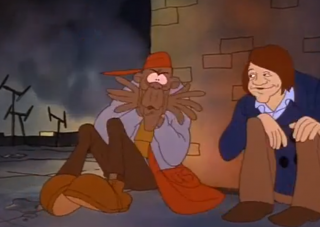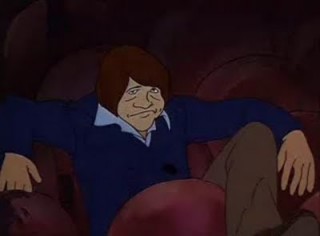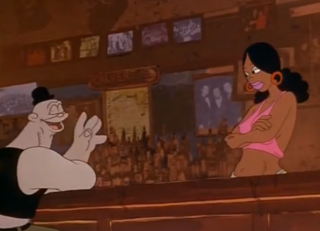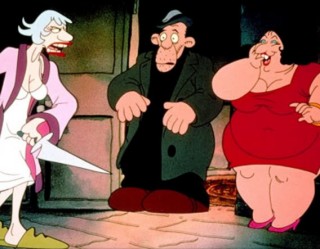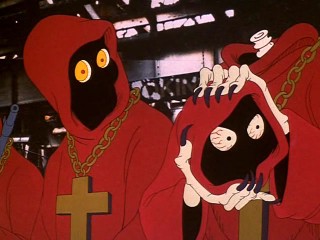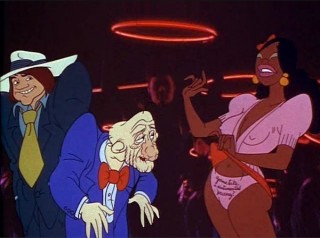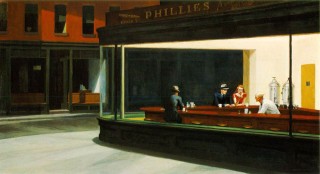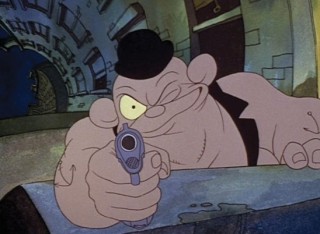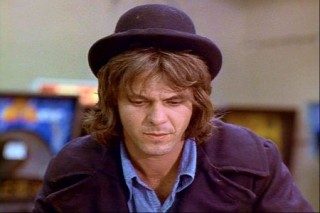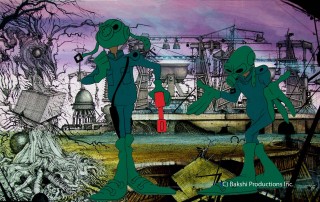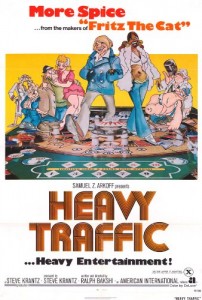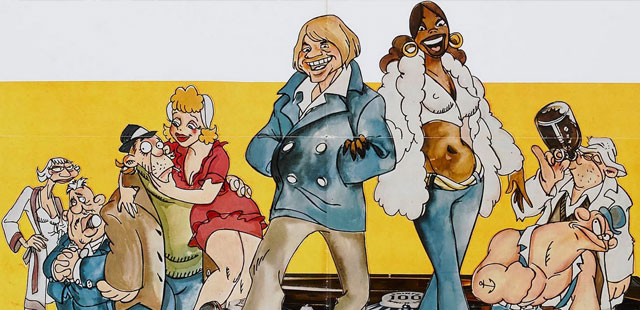
“What makes you happy? What makes you happy? Where do you go? Where do you go? Where do you hide? Where do you hide? Who do you see? Who do you see? Who do you trust? Who do you trust?” Thus begins Ralph Bakshi’s sophomore work Heavy Traffic. These are very poignant questions. Ones that main character Michael must traverse through the city streets.
The credits before these lines are over live action shots of a pinball game. As the credits recede, the live action pinball gives way to animation. This movie is full of animation over live action and the mix of the two within is way ahead of it’s time. This movie came out in 1973.
The play between focus of live action, animation, foreground and background is consistent throughout the film. When we’re introduced to Michael’s father Angelo, he’s in an animated car with live action backgrounds. Angelo is an philandering Italian working for the mob. He pulls up and gets out of his floozie’s borrowed car and she closes the door on his pants, obliterating them as she drives off. There is humor like this throughout the movie.
Pan to upstairs where we are introduced to Michael’s very Jewish mother Ida. One of her boobs never seems to stay in anything she’s wearing and several times throughout she smacks the boob, lifts out her shirt and tucks it back it. It happens more than once and every time she does this. Continuity on such a small scale is rampant in all Bakshi movies and it is this attention to detail that I find refreshing.
Michael’s parents are an odd couple to say the least. When Angelo finally makes it upstairs, Ida tries to kill him in a gas oven. “I died the day I married a goy,” she says. Escaping the oven Angelo breaks through the window in Michael’s room to get some air. “What’s a matter pop, didn’t you score last night?” “You gotta stop taking your mother’s side in these family arguments,” and then he asks Michael why he draws all the time and is never seen with a girl.
“Being 22 years old and never having been laid isn’t Italian.”Angelo
Angelo attempts to get Michael to come down with him on the docks and join the union, but Ida overhears this, “Not my son!” and a fight ensues, while Michael sits drawing, animating the fight as a fight between a man with a big penis and a single boob.
Another pinball transition finds us on the roof and there’s overlap with the faint visions of the pinball lights in the sky, again great attention was paid to detail. Where Michael meets Mo, a crazy man who came to kill his pigeon. Mo keeps saying he “ain’t dead no more” and Michael says, “you’re just a crazy nigger, Mo,” to which Mo replies “we’s all niggers boy, you and me we’s all just crazy niggers.”
This is the language of the city streets in 1973. There is no pulling punches with Bakshi’s films, including this one. He’s writing scripts based in real factual life, whether it was politically correct for the time or not. It’s something that I admire and is a bravery seldom seen in today’s cinema.
Michael and Mo set the pigeon free but not before it shits in Michael’s eye. “I set you free and you shit on me!” Mo replies, “I like that bird.” End scene.
Another pinball transition and over to Ma’s brother Jerry who promised he’d get Michael a job. The scene is surrounded by models in their underwear being filmed with the negative reversed and when Jerry snaps a photo they’re normal for a moment. This technique is brilliant. I’m not sure if it cost a lot to do or was a cost saving measure, but it sure adds to the texture of the film.
Anyway, Michael passes on the job and goes to the cinema. On the screen he watches a real movie that hits close to home. It’s of a couple arguing and when the man declares he isn’t a “one-woman man”, she shoots him.
Back to the city rooftops, Michael is accosted by a friendly enough gang who tries to set him up to sleep with Rosalyn. Michael tries to convince them he isn’t a virgin, but alas he takes off his pants and goes for it. But this isn’t Mick Jagger, this is Michael. He trips on the mattress bumps her off the roof. “She had it coming” was his reply. The scene ends with Rosalyn hanging naked from a clothesline.
Next we are introduced to Snowflake a cross-dresser, while he is getting into costume. Once Snowflake is all done up, he walks to the bar, where from an overhead angle we see that Rosalyn is still hanging from the clothesline. Into the bar Snowflake struts right over to a man who once he finds out he’s a she, beats the crap out of her. This is described as trouble for the bar and Shorty takes care of the man.
How does he take care of him? Well, let’s just say once he catches up to the guy the cut scene is a WWII bomber going down in flames.
Meanwhile, Carol the bartender is giving free booze to Michael on the roof, via a fishing pole for his drawings. Eventually, the owner comes in, has a brief discussion with Carol after which she storms off. However, she pulls the fishing line with her bringing Michael crashing down on the owner getting her fired. That’s the setup for Michael and Carol.
Carol runs into Shorty shortly after leaving the bar and responds to Shorty’s how are you with, “It’s not where I’m going its where I’ve been.” Shorty pleads with Carol to stay with him but she lies saying she secretly been seeing Michael and off the two of them go. Michael offers to let Carol stay with him, in a naive sort of way that Carol doesn’t understand, as she responds with, as long as she has her body and her brains she doesn’t need anyone. The scene cuts away and Rosalyn is still hanging from the clothesline. I really do enjoy such detail to continuity, even if some would consider it a running joke.
Eventually, Carol ends up in Michael’s room, strips down and he faints. Next, we are privileged to see Angelo down on the docks breaking up a strike. He does so in front of the Godfather, but it doesn’t go as planned. Angelo has been breaking strikes by threatening the workers with being replaced by niggers. Again he tries this, but the Godfather doesn’t want “no niggers touching his olive oil,” and Angelo is left with no leg to stand on and in a nervous fit, fails to light his cigarette with a match and shits his pants.
But Angelo has other things on his mind, he brings a woman home for Michael, still ashamed of his 22 year old virgin son. Obviously, Ida is not fond of the idea and they fight until Ida is hanging in a pair of red pajamas from a clothesline at which point she relents. Angelo then says, “30 years later I won!”
But he has only won with his wife. Before his present can really do what she’s there to do, Carol walks out of the shower and Michael introduces her as his girlfriend. Angelo is shaken and demands she leave.
The next scene is brilliant. Animated Michael and Carol are watching live action street musicians play a slow version of “Maybellene,” and the scene transitions into a full ink drawn music video of Chuck Berry’s original version of “Maybellene.”
After that, Carol convinces Michael to try and sell his art to an industry professional. The industry professional is a crusty old man in a hospital in a plastic bubble. Michael’s pitch is about religion. It’s about Mother Pile and Wanda the last. I won’t spoil the details of his pitch, but it doesn’t go well and when Michael’s finished the old man is dead.
Meanwhile, Angelo is drunk. Very, very drunk. This is done graphically, with a blending of the same background layered with different opacities. Throughout the process of the blurring of backgrounds Angelo is stumbling around with a bottle. The scene as a whole is done really well. Why is Angelo so drunk? Because he’s on his way to ask the Godfather to put a hit out on Michael, because of his interracial relationship.
His meeting with the Godfather isn’t uneventful. There are tiny nude women in the Godfather’s spaghetti. As he asks to put this hit out, three hooded figures turn their heads and a fourth one, turns his detached head to look. These four hooded figures shoot the Godfather as he yells at Angelo explaining that he is asking for a hit that is “personal, not business.” Being shot isn’t a big deal, the Godfather gets up from his table and saunters over to a pinball machine and starts playing.
Michael and Carol are trying to make ends meet. They make arrangements for Michael to be Carol’s pimp. The live dancing scenes are very reminiscent of 1930’s and 40’s choreography. Michael, with Carol’s help gets her a dance with an old-timer, mainly because he says she’s the fourth Andrews sister and she raises her skirt revealing her panties which read, “You want to take a sentimental journey?”
While Carol’s dancing, Michael runs into his very drunk mother. He breaks up her dance and tries to get her to go home. She’s falling out of her dress, pulling it up on occasion and flashing everyone. “You kids ain’t the only ones with things hanging out,” she says. The scene quickly changes to Ida by herself the lone piece of animation as a video background is overlayed with family photos. The Jewish mother in her returns and she tells stories and family gossip of everyone in the pictures.
Carol’s dance doesn’t go very well, as the old-timer couldn’t handle it and died. “It’s all bullshit,” Michael exclaims as he strikes Carol. As the walk out of the club she questions him about the size of his balls and tells him “you don’t know a friend when you sees one.”
Shorty finds about about the hit and goes looking for Angelo. Where does he find him? Down on the docks, having spent a drunken night with Snowflake. Shorty says he’ll take the contract on Michael and off they go to the apartment to fetch Angelo’s gun.
The next scene is fabulous as it is animated into Edward Hopper’s famous 1942 diner painting, “Nighthawks.” Michael is standing in the doorway across the street and Carol is inside the diner talking try to solicit someone for her scheme. The scene itself, just lingers on them in the diner and Michael outside for a while. No dialogue can be heard, but it doesn’t matter, you get the idea and it’s just beautiful the way the camera seems to just linger.
In the diner, Carol was soliciting a John, but not to sleep with. He plan is to have Michael jump out and kill the guy, then take his money. That’s how it works out and replying to Carol’s questioning of his testicles from earlier, one the deed is done he asks, “How you like my balls now?”
Michael and Carol proudly walk down the street towards Michael’s house, with the live action pinball game as their background. Meanwhile at the house, Shorty gun in hand escapes from Ida and goes into the street, eventually hiding behind the side of a stoop. As Michael and Carol approach, Shorty shoots the gun and we’re in slow motion. The bullet leaving the barrel, Michael seeing the bullet coming, and the graphic detail with which the bullet hits him between the eyes and out the back of his skull. At the sight of this, Carol turns into a crow and circles Michael as he falls down, still in slow motion.
We see Michael fall, still in slow motion, until his head wound comes into frame, where we are transported into his mind. Many of the movies characters are chasing each other in a circle and then there are visions and the devil appears. This transitions right back to the very beginning of the movie, where we now know the man playing pinball then and still now was Michael. We see him lose this game and he just goes off on the machine, turning it over and kicking it before leaving the arcade.
In all Bakshi movies, there are little things that add great humor. As Michael walks out of the arcade, we see a man playing a shooting game who loses and appears to actually get shot and someone in the photo booth who drops their pants and turns around to give the photo booth camera a full moon.
After leaving the arcade, real Michael meets real Carol as shes being fired from her job and then she leaves, as Michael is left to walk home alone. When he arrives there, we see his father having sex in a car parked out front and the camera just lingers on the car for a while.
Michael then runs back out of the apartment and searches for Carol. He finds her and after an argument they dance to “Scarborough Fair” a song that is play instrumentally throughout the entire movie here and there. Then we transition back to pinball and finally back to a dancing Michael and Carol. This is pretty heavy stuff, this is 1973 we’re talking about and the movie is ending with an interracial couple dancing in a public park.
The camera pans up and the credits roll over live video of the city.
This movie, must have been very personal to Ralph Bakshi. He wrote it and intended for it to be his first feature length film, before getting it shot down and making “Fritz the Cat” as his debut. Ralph had a Jewish mother and an Italian father. He is an artist, like Michael, and grew up to be free of prejudice.
Another interesting artistic fact about this movie is that during Michael’s pitch to the industry professional we see soldiers that resemble soldiers from Wizards, they’re wearing masks and look like the two characters from the “They’ve killed Fritz” scene.
The film is considered to be Bakshi’s biggest critical success and I can’t help but wonder how different the public would have received this film had it been his first. I also can’t help but wonder what was taken out of the film, as I’ve heard that the original script had a few scenes removed by the end of animation.
Overall, this is a classic example of the realism Bakshi takes with his dialogue and his animation. He doesn’t cut corners, pays close attention to detail and consistency and in my book, those are very high marks. Do we ever get answers to the questions asked at the start of the movie? No, but then again, those questions are questions into the meaning of our existence and life itself. To answer those would be to know the meaning of life and this film is about the journey, not the destination.
Ralph Bakshi Rotospective Archive
Read the Secret File of technical information and quotes from Ralph Bakshi’s Heavy Traffic.

